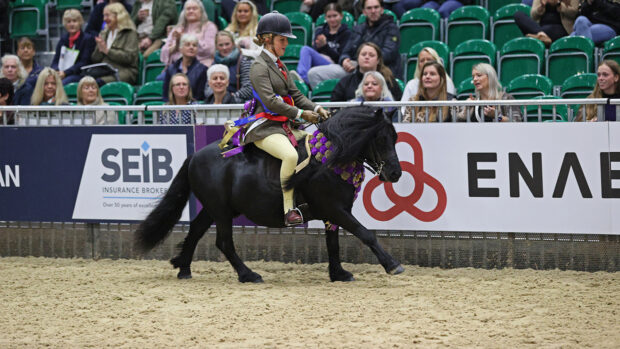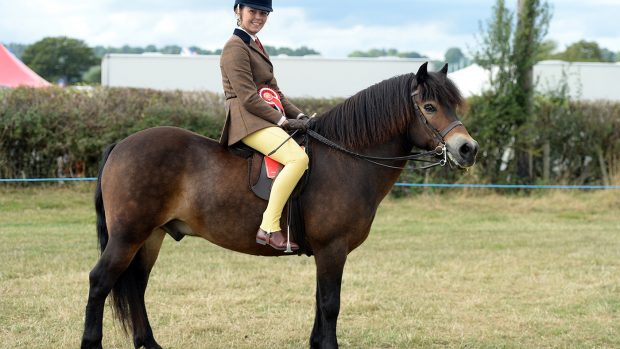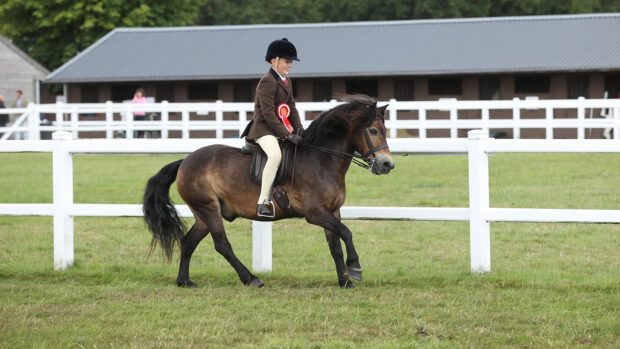An Exmoor stallion has made the long journey from Devon to a new home running with a herd in Denmark.
Farleywater Zeus, who was wild-born on the moor, has been acquired by the Danish Nature Agency to run with their Langeland ponies for the next five years.
Most recently, Zeus has been the resident stallion of the Coldicutt family’s Porlock 100 herd.
“Zeus has sired some beautiful foals but his fillies are now starting to mature, and are being retained, so he needed to find a new job,” Dawn Westcott of the Exmoor Pony Project explained.
“We always make an effort to find stallions new roles as being semi-feral and unhandled, it is not easy to find them new jobs. The Coldicutts told me a year ago they would need to move him on and fortunately the Danish Nature Agency were looking for a stallion at just the right time.”
The charismatic Zeus was registered and branded as a foal, but then went unnoticed until he was rediscovered at the age of five.
“The farmer didn’t know how he was out there, he’d avoided all the gatherings and hidden for four years,” Dawn recalled. “When I first saw him he jumped over a five-bar gate right in front of me into the pen next door — we knew we had to get him licensed and find him a job.”
Zeus found his first stallion role out on the Chains — in inhospitable part of the Exmoor that is hunting country — but when that herd had to be sold, he moved on to join the Porlock 100 herd.
“I was there when we let him go and we watched him with these new mares and he just rounded them all up and brought them into a herd, it was as if he was saying ‘I’m here now’,” Dawn said.
“A good, experienced stallion like him shouldn’t be daunted by joining the new herd at Langeland. He knows how to use the right combination of ‘assertion and seduction’. A sensible stallion will court his mares, and also show them that he is strong enough to take on the stallion role and lead the herd.
“The Langeland herd not only has mares to deal with but the foals from last year, and some geldings. They have a good amount of space and it will be interesting to see how Zeus decides to manage it.”
Zeus was transported to his new home in an LOC Transport luxury 3.5tonne horsebox that was converted into a “travelling stable” to minimise his stress.
“There was a little apprehension about how Zeus might feel being separated from his mares and detained at the farm, but he proved to be the perfect gentleman,” said Matthew Coldicutt,

“Thanks to a tip from the Exmoor Pony Project about putting him in our stock box first, then transferring him into the luxury side loading van, the operation was both safe and ordered.”
The pure but unregistered Langeland herd that Zeus has joined descends from stock that was imported to Sweden and Denmark in the mid-1960s, sourced from both Exmoor and a herd in the Welsh uplands.
The animals were initially located partly on a deserted area on Hallandsåsen in Sweden and partly on Tærø in Denmark but the ponies on Hallandsåsen were sold after a few years when the breeding project was disbanded.
“The animals at Tærø were allowed to take care of themselves until 2003 and 2006 when the Danish Nature Agency bought a number of these wild, and not pedigreed, Exmoor ponies from Tærø and placed them on the island on Langeland,” Kirsten Muus, from The Danish Nature Agency said.
“In 2006 we also bought our first breeding stallion Felix from Germany and 2013 he was exchanged with a new breeding stallion called Nemo.”
Zeus has been brought in to replace Nemo, and it is hoped that once the Exmoor Pony Genome Project is complete, it will be possible to register this herd and reclaim an important gene pool.
“Because there is no supplement and upgrading system in the Exmoor Pony Stud Book, none of the Langeland Exmoor ponies are being pedigree registered and are ‘invisible’ to the Exmoor pony breed,” Dawn explained.
Continues below…

Second Exmoor herd introduced to Czech Republic
A further 14 Exmoor ponies have been released near Prague

Watch these ‘wild’ Exmoor ponies being gathered in from the moor…
Have you ever watched a herd of wild Exmoor ponies galloping across the moor? Now is your chance...

Subscribe to Horse & Hound magazine today – and enjoy unlimited website access all year round
“As the breed is critically endangered and in decline, we are very much hoping that once the Exmoor Pony Genome Project is completed and there is the facility to offer a DNA ‘purity’ test to confirm that ponies are indeed Exmoor ponies, then a way can be found to recognise and embrace these beautiful and truly semi-feral Langeland Exmoor ponies into the breed.
“They are only using registered Exmoor stallions on their mares,” Dawn added.
For all the latest news analysis, competition reports, interviews, features and much more, don’t miss Horse & Hound magazine, on sale every Thursday.





